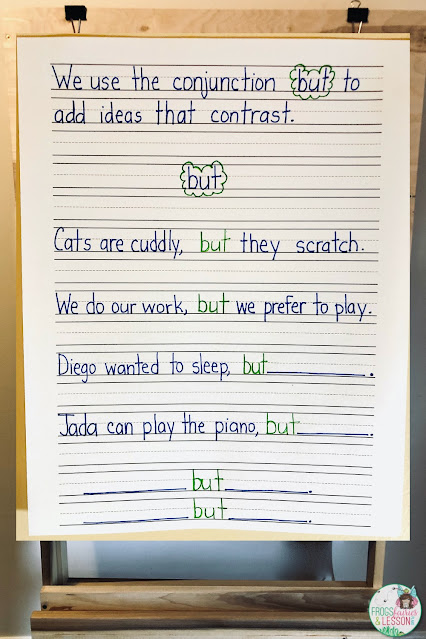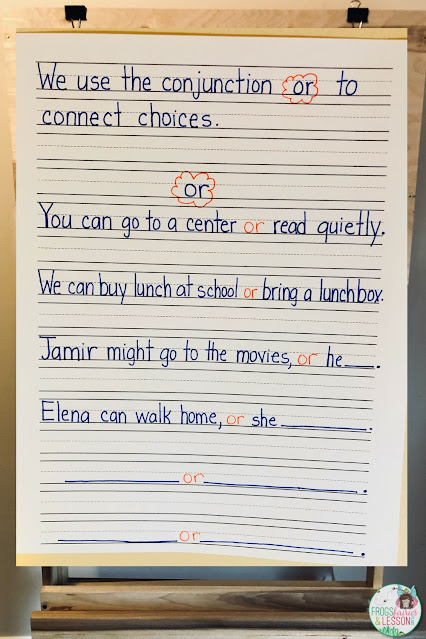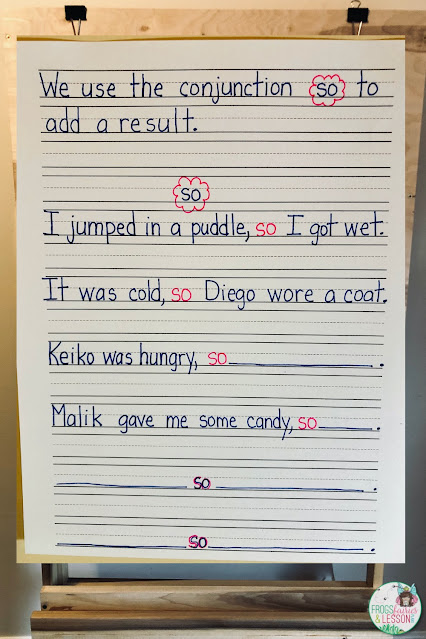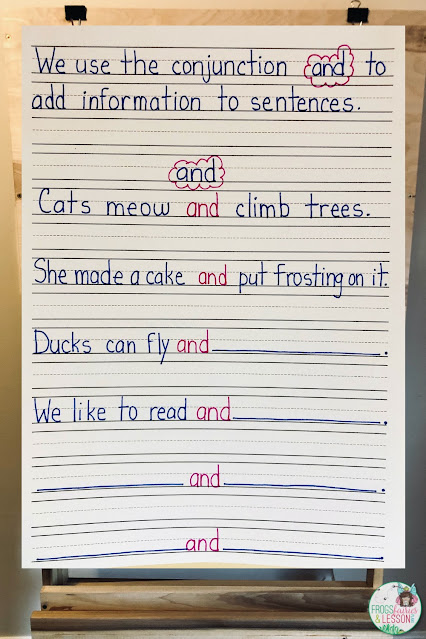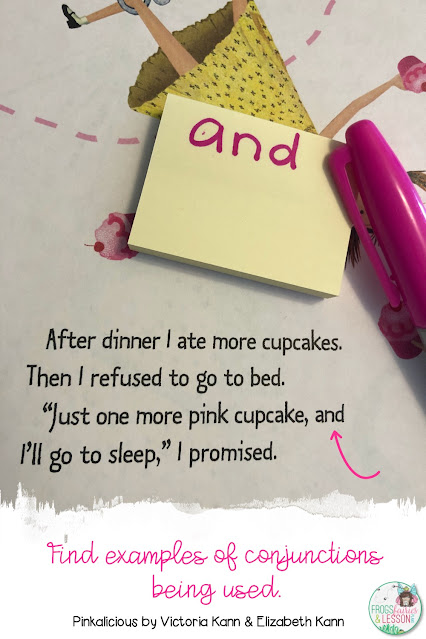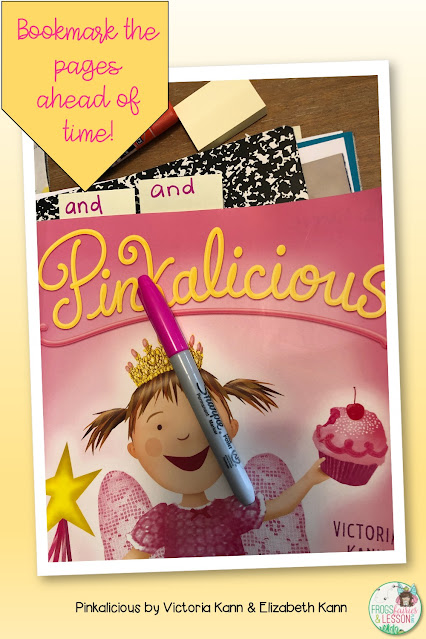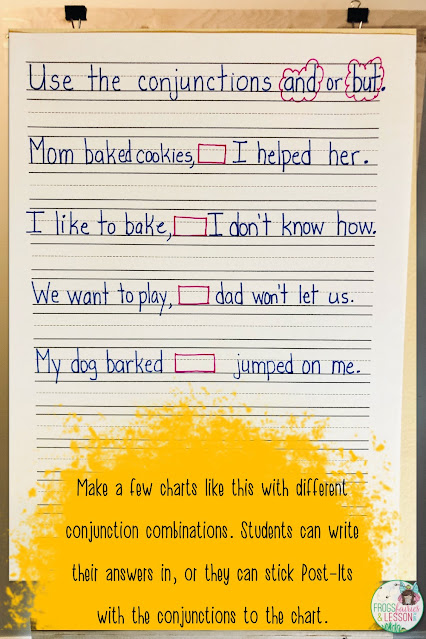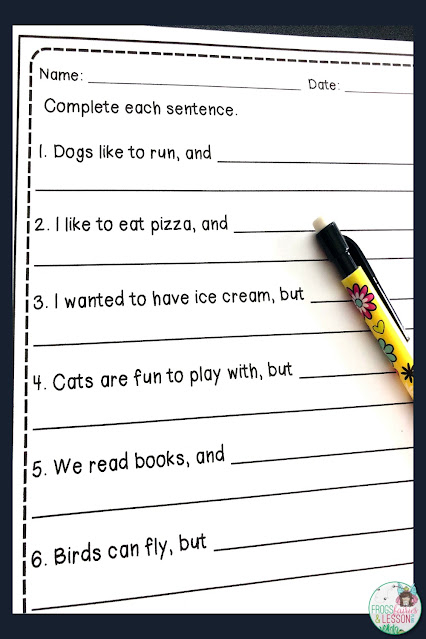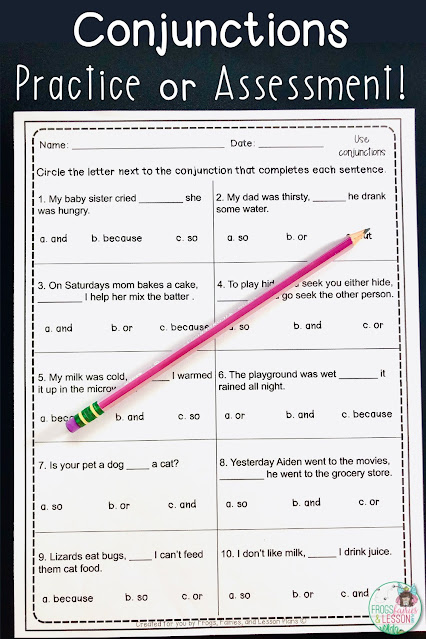When I teach Conjunctions to my students, I use Anchor Charts, Children's Books, hands on activities for guided practice, and lots of resources for independent work! I like to have a mix of books in which students can see conjunctions being used authentically, and practice worksheets crafted to direct students' focus to the skill I want them to master. I'll go over all of this with you.
Here's an overview of my Conjunction Lessons and ideas for activities you can do with your students.
Conjunction Anchor Charts
This is where I write all the information my students will need to know. I prepare all the charts ahead of time.
I know it's a big time investment upfront, but you will thank yourself later for having all the prep out of the way!
My mini-lessons start with a connection between something my students are already familiar with and new information that's on the chart.
I might say, "You already know about words that name things, and words that describe things. Today, you are going to learn about words that help connect pieces of information to each other. Those words are called conjunctions."
I'd introduce the conjunction "and" with my first anchor chart.
"Cats meow and what else? They climb trees." "The conjunction "and" is helping us understand that there's more information about what cats do. It's connecting the two things that cats do."
"She made a cake and what else? She put frosting on it." "The conjunction "and" is helping us understand that she did more than just make a cake. There's more information about what she did, and "and" connects both things that she did."
Something to consider about anchor charts:
Because all the information for the lesson is already on this chart, it can be distracting to students. I usually cover up the parts I don't want to show by folding (without creasing) the bottom of the chart up, and holding it with paper clips on both sides.
Books
I think it's important that students see what we're teaching "in isolation", in literature, in "real life". So prepare a few books ahead of time to use with your lessons.
First, look for examples.
Then, bookmark the pages with mini Post-Its.
Conjunction Hands-on Activities
For the guided practice and active engagement parts of my Conjunctions mini-lesson, I like to do hands-on activities. Here are just a few things you can do:
1. Choose the Conjunction
In this activity, students read incomplete sentences and decide what conjunction best completes the sentence. This activity only works once students have learned at least 2 conjunctions.
You can keep it simple, like this one, or you can mix more conjunction choices.
If you want to reuse your charts next year, write the conjunctions on Post-Its and have students use those instead of writing the answers in.
2. Sentence Match (Guided)
Think of a few sentences that use conjunctions. Write the first part of those sentences, up to the conjunctions, on the board. Write the second part of the sentence on sentence strips.
Students read the first sentence on the board and decide which sentence strip best completes it. Place the sentence strips on the board using tape or magnets.
3. Sentence Match Game (Independent)
This is a modification of the guided version. Simply write both parts of the sentence on strips of paper and have students mix and match until they all make sense. I have this activity as a Literacy Center game.
You can see a video of this activity in this blog post.
4. Other
Here's another sentence strip activity I did a few times in my classroom. The picture is self-explanatory.
Independent Practice for Conjunctions
For independent practice, I use a variety of practice sheets and games.
My students love these because they can practice the same skill in different ways.
I love them because I can differentiate. I can choose what level of difficulty my students are ready for, and I can pick faster activities or ones that require more time depending on our schedule.
To give you an example of what I use, this is a set of worksheets for "and/but".
This first sheet is easy and quick to complete. All the students do is read the sentences and write in the correct conjunction.
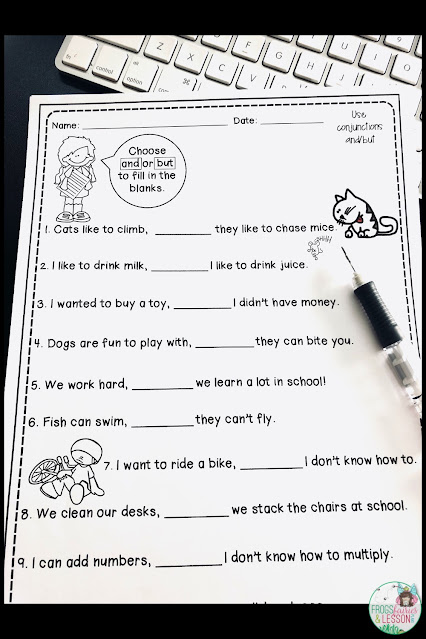 |
| Available for purchase here. |
This one is a cut and paste. It's very similar to the first, but it takes longer to complete, and targets motor and organizational skills.
Here you have another way to practice using the conjunctions "and/but", but now students have to come up with their own ideas to complete the sentences.
This multiple-choice sheet gives you a quick assessment of how well your students can use the different conjunctions you taught during your unit!
There you have it!
You can find this Conjunction Packet and other Parts of Speech packets in my TpT store. All packets include worksheets and games for your Literacy Centers.
Scroll down to see what's available.
1st Grade Parts of Speech Resources
 |
| 1st Grade Nouns |
 |
| 1st Grade Pronouns |
 |
| 1st Grade Verbs |
 |
| 1st Grade Conjunctions |
 |
| Bonus packet included in the Bundle! |
 |
| 1st Grade Prepositions |
2nd Grade Parts of Speech Resources
 |
| 2nd Grade Nouns |
 |
| 2nd Grade Verbs |
 |
| 2nd Grade Pronouns |
 |
| 2nd Grade Adjectives and Adverbs |
Language Arts Spiral Review/Homework
 |
| 1st Grade ELA Spiral Review/Homework |
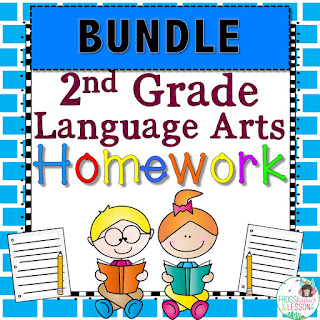 |
| 2nd Grade ELA Spiral Review/Homework |
 |
| Kindergarten ELA Spiral Review/Homework |
And last but not least! Sign up for my mailing list to receive teaching tips and samples in your inbox!
Let me send you this Parts of Speech sample as a thank you!

